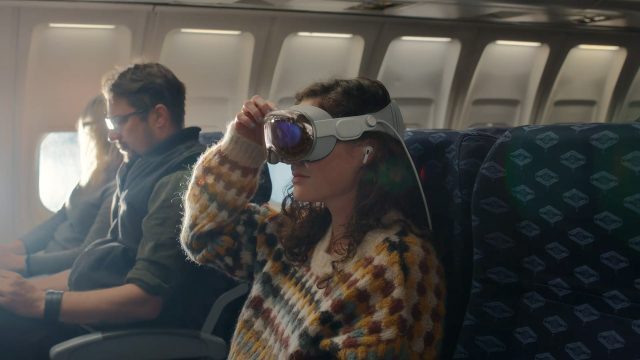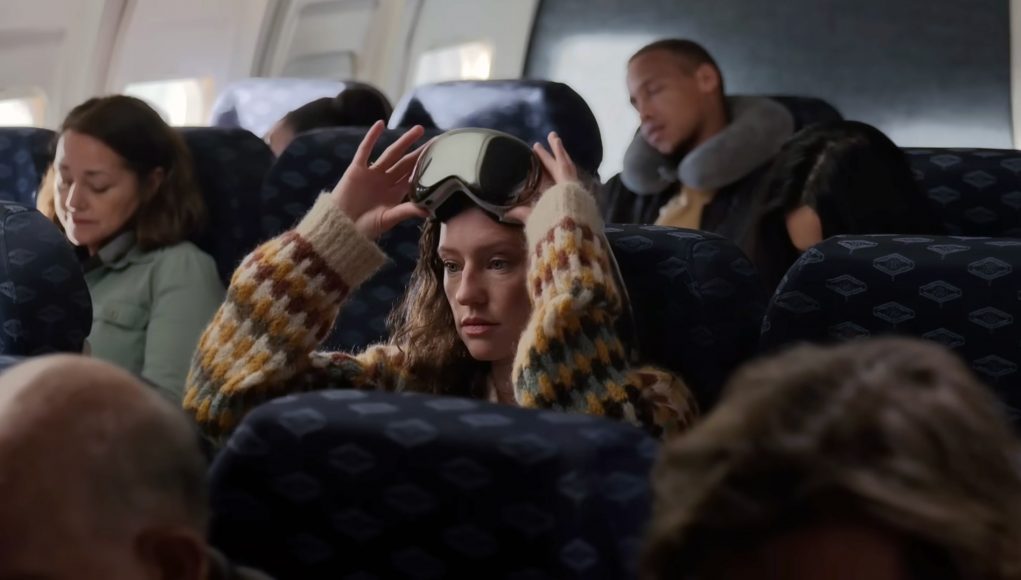After an eight hour flight, I can say that Apple has largely nailed the Vision Pro use-case of movie watching on a plane. But a few key improvements stand to make it more widely appealing.
Nobody looks forward to an eight hour flight. Whether it’s sleeping or reading or working, people want a way to pass the time and distract themselves from the noisy cabin, turbulence, and the general feeling of being packed into a metal tube like sardines.
The seat-back screen—with its selection of movies and TV shows—offers minor refuge from this chaotic environment.
I’m someone who really appreciates ‘cinematic spectacle’—you know, the movies that have the direction and action that really deserve a big screen and great audio.
While the movie selection on a plane is usually not half bad, over the years I have regularly avoided watching some movies I actually wanted to watch, because I felt they deserved much more than the experience I’d get from a small, low quality seat-back screen.
If only I could somehow bring my own movie theater on the plane.
Well, it turns out that’s a thing now.
Vision Pro on a Plane
Using a Vision Pro combined with AirPods Pro 2 on an international flight was a phenomenal experience viewing that can reasonably be described as bringing your own movie theater onto the plane.
While there’s still some obvious ways to improve the experience of using the headset on a plane, I was blown away at how it managed to make me practically unaware of the plane I was on.
This whole thing really only works well because Apple has done a few things to make sure the use-case is not just theoretical, but actually considered from end-to-end.
For one, Vision Pro has a special tracking mode called Travel Mode (not to be confused with Airplane Mode) which allows the headset to keep the floating screen locked in place in front of you even though the airplane is moving. Without it, the headset would detect the motions of the plane and cause the screen to go flying off behind you at worst, or slowly drift out of place at best.
Travel mode managed to keep the screen perfectly locked in place in front of me, with no drift throughout the entire duration of the movie. I put the screen out in front of me and made it 20 feet large.
 This would have otherwise created a stereoscopic disparity by going ‘through’ the seats in front of me, turning Vision Pro’s digital crown to add an immersive backdrop behind the screen (which fades out to the passthrough view at the edges) worked perfectly to prevent that. It ended up looking like a soft portal to another dimension was open right in front of me… with a huge TV just on the other side.
This would have otherwise created a stereoscopic disparity by going ‘through’ the seats in front of me, turning Vision Pro’s digital crown to add an immersive backdrop behind the screen (which fades out to the passthrough view at the edges) worked perfectly to prevent that. It ended up looking like a soft portal to another dimension was open right in front of me… with a huge TV just on the other side.
Then there’s simply the quality of the display. When it comes to movie viewing, it’s not just resolution that matters. The headset’s HDR capability combined with micro OLED (which offers true blacks) really makes videos shine.
But none of this would matter if it wasn’t easy to find and transfer high quality video content onto the headset.
Luckily it was as simple as opening the Apple TV app before my flight where I downloaded Mad Max: Fury Road (2015)—at 4K resolution with surround sound, HDR, and in 3D—for offline viewing on my headset.
Lost in the Best Way
What’s crazy is that despite being stuck in a plane in an economy seat, this was the best way I’ve ever watched Mad Max on any screen. The quality was great. The 3D is better than what you get in a movie theater, and so is the contrast. Using AirPods Pro 2 also gave me a really impressive audio experience, and I couldn’t believe how well the noise cancellation isolated me from the noise of the plane.
With a high quality video on a huge screen, great sound with noise cancellation, and a movie with constant action, I was lost in an audio-visual reality that practically made me forget I was on a plane. In fact I have to admit that I was so lost in the film that I forgot to capture and screenshots for this article!
 But I wasn’t completely unaware… on purpose. I didn’t dial the immersive environment up to 100% (which would have completely surrounded me and made it look like I wasn’t in the plane at all), which meant I could still look off to the side and see what was happening in the cabin so I didn’t need to worry that I’d miss a drink when the flight attendants came by.
But I wasn’t completely unaware… on purpose. I didn’t dial the immersive environment up to 100% (which would have completely surrounded me and made it look like I wasn’t in the plane at all), which meant I could still look off to the side and see what was happening in the cabin so I didn’t need to worry that I’d miss a drink when the flight attendants came by.
Not for Everyone (yet)
The movie watching experience I had with Vision Pro on the plane was vastly better than what I’ve ever had from a seatback screen or a laptop.
But it’s not a perfect experience and there’s still some things that need to be improved before everyone would want to watch movies on the plane this way.
First are the obvious things. Vision Pro is big, and even bigger when it’s in a travel case. At this price, it’s not the kind of headset you’re just going to squeeze into a backpack without any protection. The headset in its travel case took up like 80% of the space in the backpack I carried onto the plane.
When I was ready to pull the headset out, it was fairly clunky to pull the case out of my backpack, unzip and fold it open in my lap, then pull out the headset and battery before getting the headset plugged in and putting the case back under my seat. In the cramped space of an economy seat, it’s a bit of a juggling act.
The only real fix for this is a smaller and more affordable headset. And even better if they can eventually ditch the battery pack. But in the interim, I could easily see an airline offering Vision Pro headsets built into a compartment in first class seats. Not only could these be permanently powered through a tether, but passengers wouldn’t need to carry a bulky case with them onto the plane to get a great movie watching experience.
Although hand-tracking worked incredibly well considering how dark the cabin was, Vision Pro would occasionally give me a ‘Tracking Lost’ message when I shuffled around a little too much—likely a limitation of Travel Mode. Luckily Apple thoughtfully pauses the movie when this happens, and in three or four seconds the tracking would come back and the movie would start playing again.
This happened a handful of times as I watched the movie. Because I understand the tech and the challenge of tracking the headset in this worst-case environment, it didn’t bother me that much. But for a normal person this would probably feel like quite a disruption to the movie experience if it happened multiple times.
Visual and audio isolation is the point if you’re using a headset on a plane, but this can make it hard for someone to get your attention. Passthrough is of course helpful here, but the field-of-view is tighter than your natural field-of-view, making it harder to see things out of the corner of your eye. This makes it more difficult for someone to get your attention (like a fellow passenger who wants to politely interrupt you so they can get out of the seats and to the bathroom).
And of course there’s battery life. After watching the full two hours of Mad Max: Fury Road, I was left with 35% battery on Vision Pro. Although that means I had another hour to squeeze in a show or two, only being able to watch one full length movie on an eight hour flight is an obvious and unfortunate limitation.
And yes I could have brought a big external battery and plugged it into Vision Pro’s battery to extend the runtime, but now we’re talking about adding more bulk, wires, and juggling to the equation.
Personally I was willing to put up with these various hassles to watch a movie with excellent audio and visual quality on a plane. And I’ll do it again.
But I recognize that not everyone cares that much about what a movie looks and sounds like. For those people, Vision Pro is just not convenient enough for the value it would bring them. But once it gets smaller (and losses the battery pack), this use-case will become appealing for a much larger group of people.







